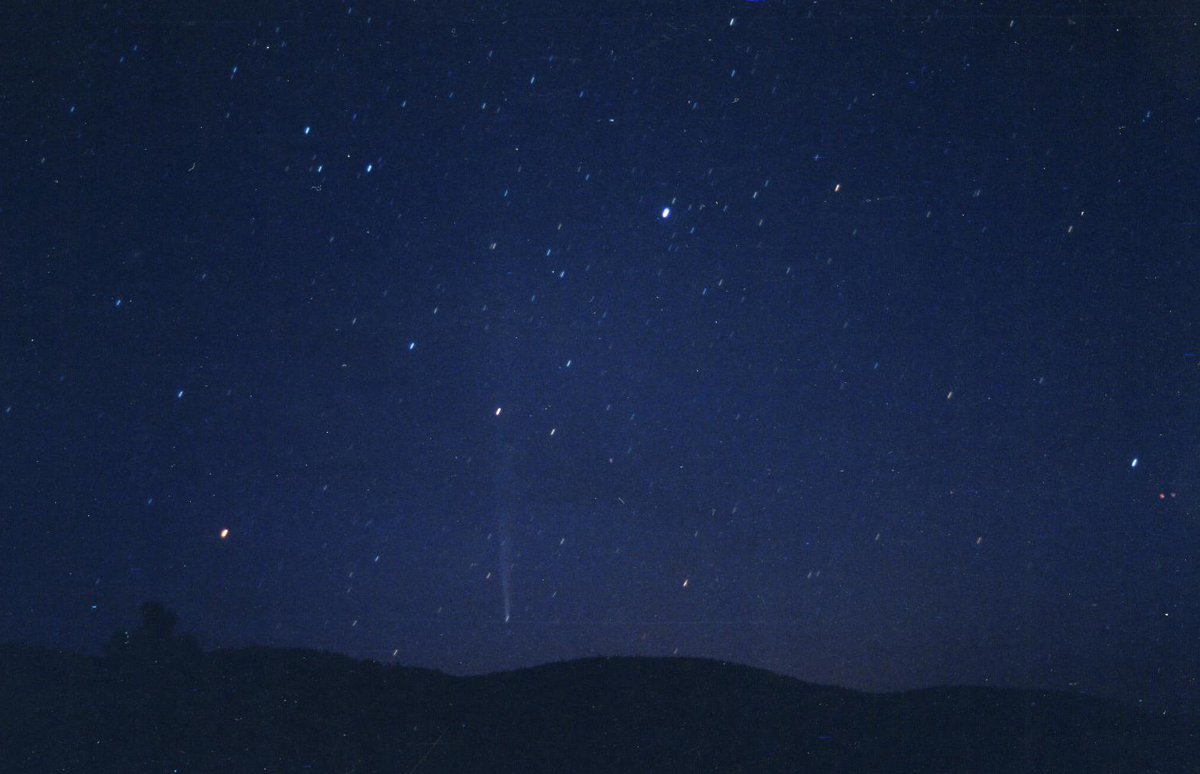

COMET OF THE WEEK
WEEK 18: APRIL 26 -- MAY 2
COMET BRADFIELD C/2004 F4
Perihelion: 2004 April 17.09, q = 0.168 AU
Bradfield’s 18th, and last, comet was also one of his best. He discovered it low in evening twilight on March 23, 2004 as an 8th magnitude comet and successfully re-observed it the following night, however due to poor weather and its low location it eluded detection for the next two weeks before he and other observers successfully relocated it, by which time its brightness had increased to about 4th magnitude but its elongation had dropped to 17 degrees. The discovery was formally announced on April 12, and the very preliminary orbit available then indicated an imminent perihelion passage at a small heliocentric distance, and also indicated it would soon become visible in the LASCO C3 coronagraph aboard the SOlar and Heliospheric Observatory (SOHO) spacecraft.
Comet Bradfield entered the C3 field of view late on the 15th, and for the next five days put on a spectacular show in the C3 images as it traveled from south to north, and exhibited a tail up to eight degrees long. The comet was passing between Earth and the sun at the time – with the minimum distance from Earth being 0.83 AU on the 19th – and with phase angles as high as 164 degrees it undoubtedly exhibited a significantly enhanced brightness due to forward scattering of sunlight.
After exiting C3 Comet Bradfield began appearing in the northern hemisphere’s morning sky around April 22, initially as a 4th-magnitude object deep in twilight. As it climbed higher into the morning sky over subsequent mornings it became rather easily visible to the unaided eye, and exhibited a long filmy tail for which I measured a maximum length of 8½ degrees near the end of the month. Meanwhile the comet began to fade fairly rapidly, being near 5th magnitude during the last few days of April and dropping below naked-eye visibility in early May. It remained visually detectable until late May or early June – by which time it had become quite vague and diffuse – and the final observations were obtained in mid-September, by which time it had faded to magnitude 19 or 20.

 LEFT: Comet Bradfield in the LASCO C3 coronagraph aboard SOHO on April 18, 2004. The horizontal “bar” through the coma is an artifact due to saturation of the pixels in the camera caused by the comet's high brightness. Image courtesy NASA/ESA. RIGHT: Photograph I took of Comet Bradfield on April 26, 2004.
LEFT: Comet Bradfield in the LASCO C3 coronagraph aboard SOHO on April 18, 2004. The horizontal “bar” through the coma is an artifact due to saturation of the pixels in the camera caused by the comet's high brightness. Image courtesy NASA/ESA. RIGHT: Photograph I took of Comet Bradfield on April 26, 2004.
On one morning in late April I successfully observed Comet Bradfield and another comet, Comet LINEAR C/2002 T7, simultaneously with my unaided eye – the first of only two occasions in my life when I have obtained such an observation. Comet LINEAR was low in the southeastern sky at the time and soon became accessible only from the southern hemisphere (although it came back north after it had faded); curiously, observers in the southern hemisphere were able to observe it simultaneously with another naked-eye comet, Comet NEAT C/2001 Q4. This comet was still relatively bright, at 3rd magnitude, when it became accessible from the northern hemisphere in early May, and remained visible to the unaided eye for another month.
William Bradfield would not discover any additional comets, and he passed away in June 2014 at the age of 86. With all the comprehensive survey programs that are now operational and with even more expected to come on-line within the not-too-distant future, it is quite certain that we will never again encounter someone with his level of success at the art of visual comet hunting.
“Comet of the Week” archive
Ice and Stone 2020 home page
Earthrise Institute home page